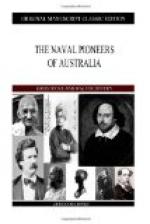The 102nd served at various home stations until 1812, when it was sent to the Bermudas, and in 1814 took part in an expedition against Mosse Island, in America. In 1816 the 102nd became the 100th [Sidenote: 1823-1870] Regiment; and on the 24th of March, 1818, the regiment was disbanded, and the regiments which were afterwards thus numbered have no connection with it.
The veteran company lasted until 1823, being linked to each regiment of foot that came out to the Australian station. The 73rd was followed by the 46th; then came the 48th, and soon afterwards the New South Wales Veteran Company, as it was called, was abolished. Imperial troops from that time onward garrisoned the Australian colonies until 1870, when they were withdrawn, and their places taken by the permanent artillery regiment, the militia, and the volunteer forces, raised under constitutional government.
CHAPTER VII.
GOVERNOR KING.
For the reason that all the contemporary historians were officers, and their writings little more than official accounts of the colonization of Australia, the personality of the naval governors never stands out from their pages. The German blood in Phillip seems to have made him a peculiarly self-contained man; the respect due to Hunter, as a fine type of the old sea-dog, just saves him from being laughed at in his gubernatorial capacity; King, however, by pure force of character, is more sharply defined. In reading of his work we learn something of the man himself; and of all Phillip’s subordinates in the beginning of things Australian, he, and he alone, was the friend of his cold, reserved chief.
Philip Gidley King was twenty years younger than Phillip, and was thirty years of age when he, in 1786, joined the Sirius as second lieutenant. In a statement of his services sent by himself to the Admiralty in 1790, he supplied the following particulars:—
“Served in the East Indies from the year 1770 to 1774 on board His Majesty’s sloop and ships Swallow, Dolphin, and Prudent; in North America in His Majesty’s ships Liverpool, Virginia, Princess, and Renown from the year 1775 to 1779. I was made a lieutenant into the last ship by Mr. Byron November 26th, 1778. On Channel service, Gibraltar, and Lisbon, in His Majesty’s sloop and ship Kite and Ariadne from 1780 to 1783; in the East Indies in His Majesty’s ship Europe from 1783 to 1785; in New South Wales in His Majesty’s ship the Sirius from 1786 to 1790. This time includes the ship being put in commission, and my stay at Norfolk Island to this date. In His Majesty’s service twenty years; twelve years a lieutenant.”
King had entered the service when he was twelve years of age, and was previously under Phillip in the Europe. He was probably the best educated of the officers in the first




